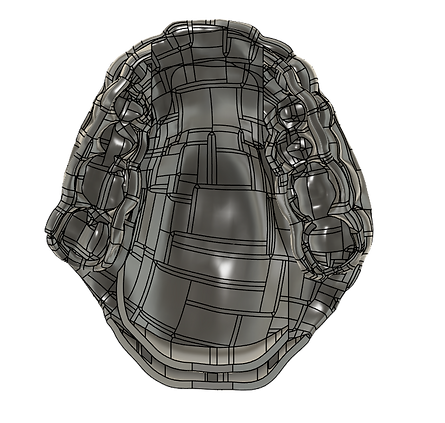
How common is OSA?
OSA is alarmingly prevalent.
-
Nearly 1 billion adults aged 30 to 69 are estimated to have OSA globally, with the majority (60%) with mild disease and the remaining 40% with moderate to severe disease.
-
Approximately 170 million individuals in North and South America have some degree of OSA.
-
The estimated prevalence of OSA in 50 European countries was approximately 175 million.
-
According to the American Medical Association, more than 30 million people in the United States have sleep apnea, however, only 6 million people are officially diagnosed. More recent estimates have that number at more than 80 million as of 2024.
-
According to the American Sleep Apnea Association, undiagnosed moderate to severe level obstructive sleep are estimated to represent 80% of those who have this sleep disorder.



.png)

What treatments are available and how well do they work?
Let's look at the history of the diagnosis and treatment of OSA and the “Gold Standard” of OSA treatment.
Sleep apnea wasn’t recognized as an official disorder until the late 20th century, but its symptoms were noticed and remarked upon more than 2000 years ago. Research into the sleep apnea started to really take off in the 1970s. Initially, researchers looked at sleep apnea in dogs and used surgical airways called tracheotomies to treat the condition. And as crazy as it sounds, it soon became the treatment for humans as well as it was the only way researchers could figure out how to get air past the airway obstruction. Eliot Philipson was researching ways to help dogs with respiratory problems.
In the late 1970s a researcher Colin Sullivan joined Philipson in his project and developed a mask that seemed to help dogs that didn’t require surgery. Sullivan is credited as the inventor of the CPAP machine, and he first tested positive airway pressure on dogs. To help open up the airways, Sullivan used a vacuum cleaner set to blow air out as the first version of a positive airway pressure machine. This technology would quickly spread to humans. The first CPAP machine was actually a modified paint compressor with tubing that connected to a face mask. Airflow with positive pressure was delivered through a mask which was the earliest form of continuous positive airway pressure or CPAP. The first CPAP device for humans was developed in 1981.
The early CPAP machines were incredibly loud, airflow was poorly controlled, but some patients were finally able to get some sleep without constantly waking themselves up. CPAP machines have steadily improved in design, functionality, and comfort, but the underlying principle to use positive pressure to force open passages between soft tissue in the airway is the same. In the 1990s the first self-sealing masks called bubble masks were produced by Philips Respironics to increase comfort. Comfort and compliance with CPAP was known to be a problem with CPAP from the very beginning. Colin Sullivan was quoted as having said “I often ask my patients to think of CPAP like reading glasses. They are a nuisance but you can’t do without them.” So from the inception of CPAP as a medical therapy, compliance was known to be a huge issue and noncompliance with CPAP continues in spite of all the advances in comfort, machinery, and functionality. Nonetheless, CPAP is still considered a much better treatment option than tracheotomy.
The problem with CPAP is poor compliance with patients. The process of acclimation to using CPAP can be rarely just a few days. Most users take anywhere from 30-60 days to get acclimated to CPAP therapy. Thus partially the reason for the high noncompliance rate. Difficulties with initial use are many and varied. Patients can have mouth leak or inappropriate pressure settings causing users to want to take off the masks. Mask discomfort is another top reason for noncompliance. Many patients complain of worse quality sleep with CPAP than without CPAP causing them to give up pretty quickly. Dry mouth or nose is another common complaint. Some doctors will prescribe sleep aids, sedatives, and tranquilizers to help with adjusting and sleeping with CPAP. CPAP machines are complex. There have been recent global recalls on CPAP machines specifically with the foam used in devices to reduce sound and vibration. The foams were found to breakdown and were being inhaled by patients exposing them to chemicals which can have toxic carcinogenic effects in addition to potentially blocking the airway path.
As PAP has emerged as an effective treatment of OSA, oral appliances have been identified as an alternative treatment modality. Per the American Academy of Sleep Medicine guidelines, oral appliances are indicated for treatment of mild and/or positional OSA. Oral appliances are broadly divided into devices that protrude the mandible forward known as mandibular advancement devices and tongue-retaining devices. The goal of these devices is to maintain upper airway patency during sleep by changing upper airway geometry and by decreasing and improving the pharyngeal critical closing pressure. Some of the potential negative side effects of these oral appliances include bite changes/alignment problems, teeth shifting, teeth discomfort, jaw pain, poor fitting devices causing discomfort, or too much/too little saliva during sleep.
Both CPAP and oral appliances can treat OSA, but compliance with patients is poor.
Due to the multitude of factors that make PAP(positive airway pressure) devices uncomfortable to wear and keep on throughout the night, noncompliance with PAP devices is very high. CPAP (the gold standard for OSA treatment) noncompliance is at least 50% and some studies show CPAP noncompliance in the first year as high as 80%. Most patients find CPAP masks and/or machines very difficult to tolerate.
Oral appliances therapies also report a high rate of noncompliance. Only 32% patients reported using the appliance regularly. Most of the non-adherent patients had stopped using their appliances in the first year (55%).